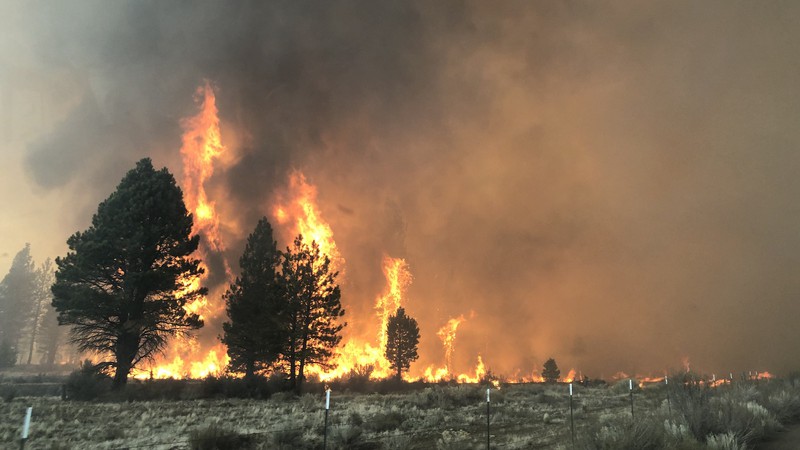
A raging Oregon wildfire is bearing down on one of California's main power transmission routes. National Interagency Fire Center / Wikimedia Commons CC 1.0 Universal Public Domain Dedication
Fires, heat waves, and drought are holding the state in a vise grip this month, forcing Governor Gavin Newsom to implore Californians to put the squeeze not only on the amount of water they use, but the amount of electricity as well.
Last Friday, July 9, Newsom signed an emergency proclamation to make more energy available to residents, as a raging fire in southern Oregon threatened to short out portions of California’s power grid as it bore down on transmission lines that send electricity into the state, according to a report by Kurtis Alexander and Dominic Fracassa in the San Francisco Chronicle.
The new emergency came the day after the governor extended the state’s drought emergency to 50 of the 58 counties, covering about 42 percent of California’s population. At the same time Newsom asked all Californians to reduce their water consumption by 15 percent, “not only on residences but industrial commercial operations and agricultural operations,” he said, as quoted in the Los Angeles Times.
Newsom added that the state government was not attempting to act as a “nanny state,” stressing that his request for a 15 percent water-use cutback would be voluntary. If the 15 percent reduction standard is actually met, it would save enough water to meet the needs of 1.7 million households for a year, according to state officials.
The counties newly added to the drought emergency include Santa Cruz, Santa Clara and Monterey—along with San Luis Obispo, Inyo, Marin, Mono, San Mateo and Santa Barbara. Though Newsom made sure to note that the water cutbacks were voluntary, the emergency declarations give the state increased authority to cut off water for farmers whose use becomes excessive.
Pressure to use less water was soon accompanied by pressure from the state for consumers to switch off air conditioners and other big drains on the electricity supply, thanks to a massive fire that could sharply reduce California’s power supply.
Known as the “Bootleg Fire,” the blaze—which was sparked last Tuesday, July 6—tripled in size over the past weekend and now approaches a complex of high-tension power lines known as “Path 66.” Those lines zap electricity all the way from the Oregon’s northern border down to Southern California. According to a report by Brandon Rittiman of KXTV in Sacramento, the state could lose 5,000 megawatts of power if Path 66 goes down.
That’s equivalent to 10 percent of the energy consumed by California in its highest moment of power consumption on record, which occurred on July 24, 2006, according to the KXTV report.
The potential energy crisis comes at a moment when California’s power grid is already under stress from a scorching heat wave that produced temperatures well into the triple digits in regions throughout the state, including a 120 degree day in Palm Springs on July 10, a new record (by one degree) even for that arid climate.
The heat wave and the spike in power consumption that inevitably accompanied it caused the California Independent System Operator—the nonprofit company in charge of the state’s power grid—to call on Caifornians to reduce their electricity use between 4 and 9 p.m. each day, a call emphasized by Newsom last Friday.
Read the San Francisco Chronicle report.
Short articles summarizing reporting by local news sources with linkbacks to the original content.